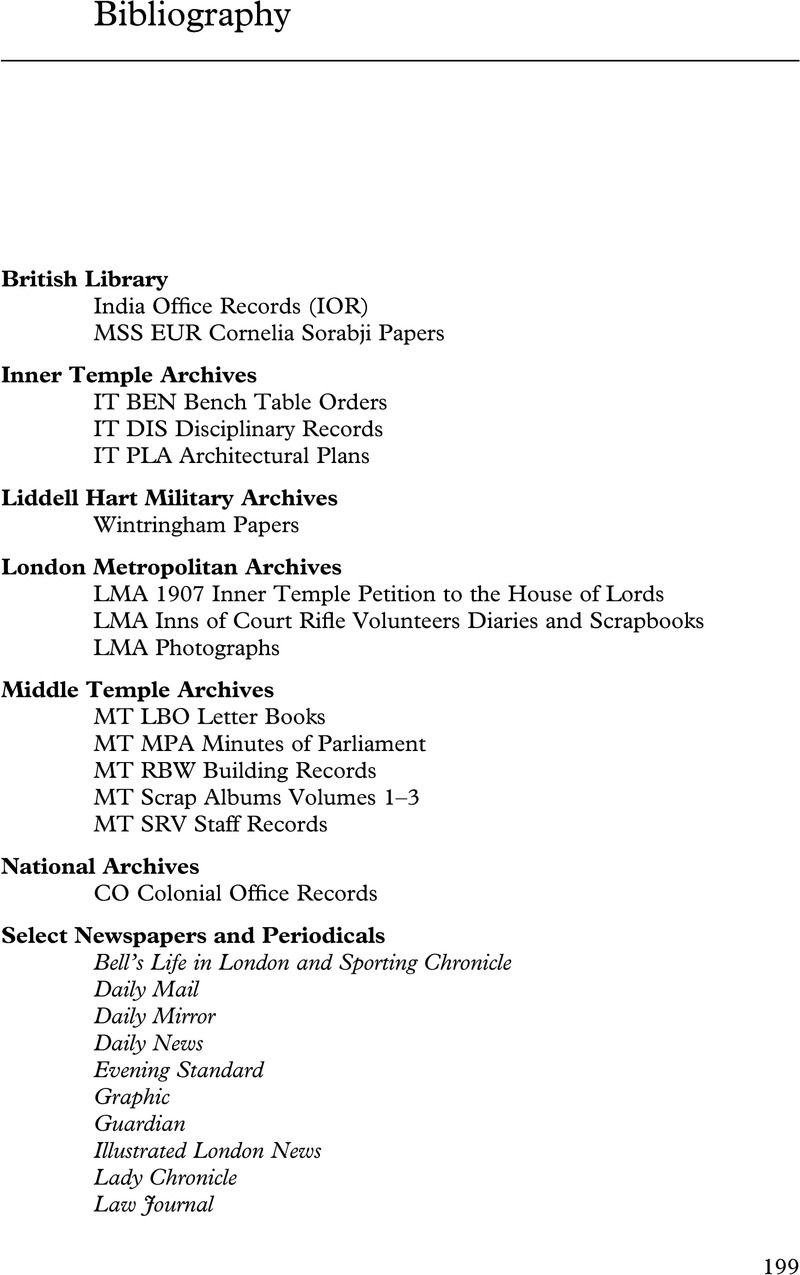Published online by Cambridge University Press: 11 April 2024

India Office Records (IOR)
MSS EUR Cornelia Sorabji Papers
IT BEN Bench Table Orders
IT DIS Disciplinary Records
IT PLA Architectural Plans
Wintringham Papers
LMA 1907 Inner Temple Petition to the House of Lords
LMA Inns of Court Rifle Volunteers Diaries and Scrapbooks
LMA Photographs
MT LBO Letter Books
MT MPA Minutes of Parliament
MT RBW Building Records
MT Scrap Albums Volumes 1–3
MT SRV Staff Records
CO Colonial Office Records
Bell’s Life in London and Sporting Chronicle
Daily Mail
Daily Mirror
Daily News
Evening Standard
Graphic
Guardian
Illustrated London News
Lady Chronicle
Law Journal
Law Times
Lloyd’s Weekly Newspaper
Morning Chronicle
Morning Post
Pall Mall Gazette
Punch, or the London Charivari
Times
Vote
HLN Helena Normanton Papers
India Office Records (IOR)
MSS EUR Cornelia Sorabji Papers
IT BEN Bench Table Orders
IT DIS Disciplinary Records
IT PLA Architectural Plans
Wintringham Papers
LMA 1907 Inner Temple Petition to the House of Lords
LMA Inns of Court Rifle Volunteers Diaries and Scrapbooks
LMA Photographs
MT LBO Letter Books
MT MPA Minutes of Parliament
MT RBW Building Records
MT Scrap Albums Volumes 1–3
MT SRV Staff Records
CO Colonial Office Records
Bell’s Life in London and Sporting Chronicle
Daily Mail
Daily Mirror
Daily News
Evening Standard
Graphic
Guardian
Illustrated London News
Lady Chronicle
Law Journal
Law Times
Lloyd’s Weekly Newspaper
Morning Chronicle
Morning Post
Pall Mall Gazette
Punch, or the London Charivari
Times
Vote
HLN Helena Normanton Papers
To save this book to your Kindle, first ensure no-reply@cambridge.org is added to your Approved Personal Document E-mail List under your Personal Document Settings on the Manage Your Content and Devices page of your Amazon account. Then enter the ‘name’ part of your Kindle email address below. Find out more about saving to your Kindle.
Note you can select to save to either the @free.kindle.com or @kindle.com variations. ‘@free.kindle.com’ emails are free but can only be saved to your device when it is connected to wi-fi. ‘@kindle.com’ emails can be delivered even when you are not connected to wi-fi, but note that service fees apply.
Find out more about the Kindle Personal Document Service.
To save content items to your account, please confirm that you agree to abide by our usage policies. If this is the first time you use this feature, you will be asked to authorise Cambridge Core to connect with your account. Find out more about saving content to Dropbox.
To save content items to your account, please confirm that you agree to abide by our usage policies. If this is the first time you use this feature, you will be asked to authorise Cambridge Core to connect with your account. Find out more about saving content to Google Drive.